As a child, Jim Conlin spent several weeks every summer on the Massachusetts family farm where his father had grown up. It was a world of “build and fix”; early on he knew the difference between a wood screw and a carriage bolt, and among his earliest memories is a large jar of fastenings. On the farm and at home, just outside Boston, he fixed bikes and built soapbox cars and model airplanes. There were no boats until, in the early 1950s when he was 12, his parents signed him up at the Community Boating facility on the banks of the Charles River in Boston. He could ride his bike to the center and sailed Mercuries, Fireflies, 110s, and Thistles. When he went off to college, he captained the sailing team.
Through the ensuing years of adulthood, Jim was never far from the water. In his early 30s he and his wife bought a first-generation fiberglass Alberg 35, which they cruised on the Maine coast for 25 years before selling it in 2000. His daughter grew up sailing the sloop and was so attached to it that in recent years she and her partner found it and bought it back. It also inspired Jim’s first boatbuilding project: a stitch-and-glue pram to replace the old ’glass tender that had come with the Alberg.
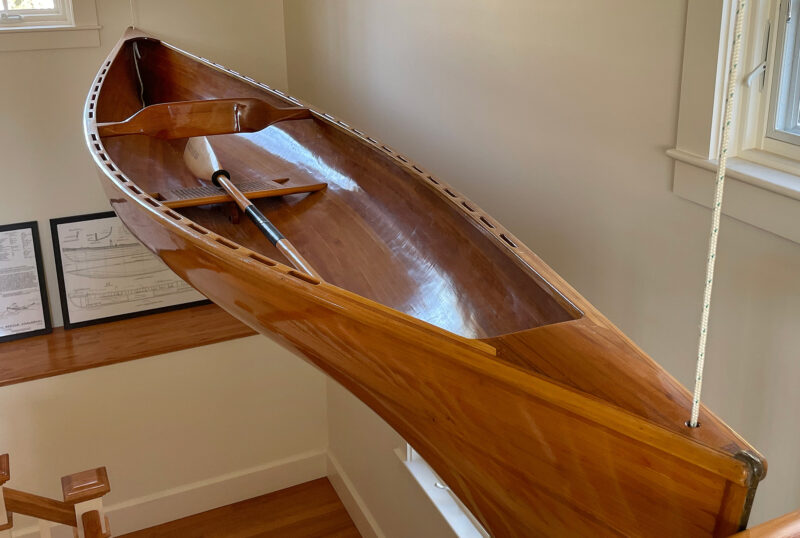 Jim Conlin
Jim ConlinEarly in his boatbuilding career Jim became enamored of small wooden canoes and built a Wee Lassie designed by Mac McCarthy. He was pleased with the outcome but quickly realized he was not built for such a small, tender vessel. Today the Wee Lassie hangs in a stairwell in Jim’s home.
Next came a canoe. Living near a river, Jim thought a canoe would be fun and bought CanoeCraft by Ted Moores, a manual on building canoes with wood strips and epoxy. The resulting boat, he says, “came out well. It gave me my first experience of the satisfaction that comes from building something pretty.” He still has that first canoe and, just as sailing had in his childhood, boatbuilding now hooked him.
He came across a WoodenBoat article about the Piccolo lapstrake sailing canoe designed by Robert Baker, and suddenly it seemed there were small wooden canoes everywhere he looked. Jim was enchanted: “I had to build a fancy little canoe,” he says, “whether I needed one or not.” He chose a Wee Lassie designed by Mac McCarthy and described in his book Featherweight Boatbuilding. As with the canoe before it, Jim was pleased with how it turned out, but he found he lacked the agility to use it and it was destined to become largely decorative. Today it hangs in a stairwell at his home in Padanaram, Massachusetts.
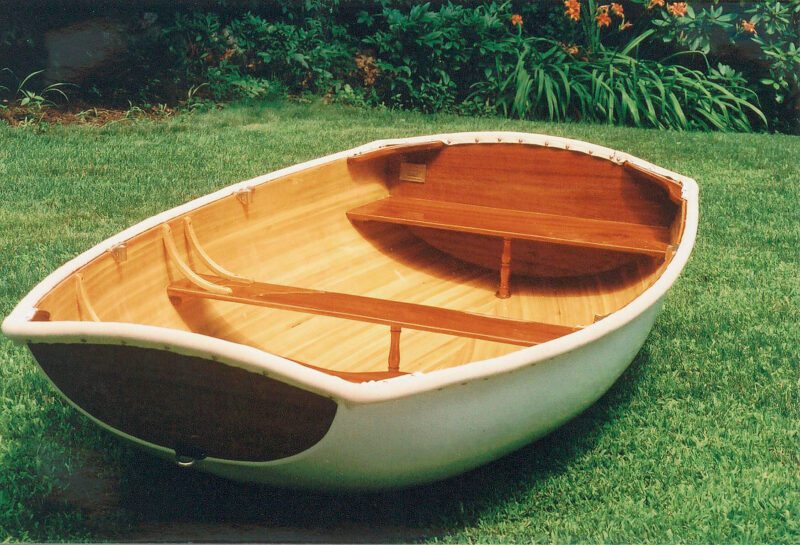 Jim Conlin
Jim ConlinThe cedar-strip L. Francis Herreshoff pram described by John Gardner in his book, Building Classic Small Craft, was Jim’s first boatbuilding commission.
Around the same time, Jim was traveling with his first canoe on top of his car and was approached by a woman who said she was looking for someone to build a dinghy for her husband’s birthday. She wanted, she said, a tender to a Dark Harbor 17, a 26′ gaff-rigged sloop. Jim had been thinking about building small boats as a sideline to his real job in computer technology and leapt at the chance. “I hung out a shingle and Conlin Boatworks was born,” he says. “We had a motto: We don’t do good work, but we’re slow!”
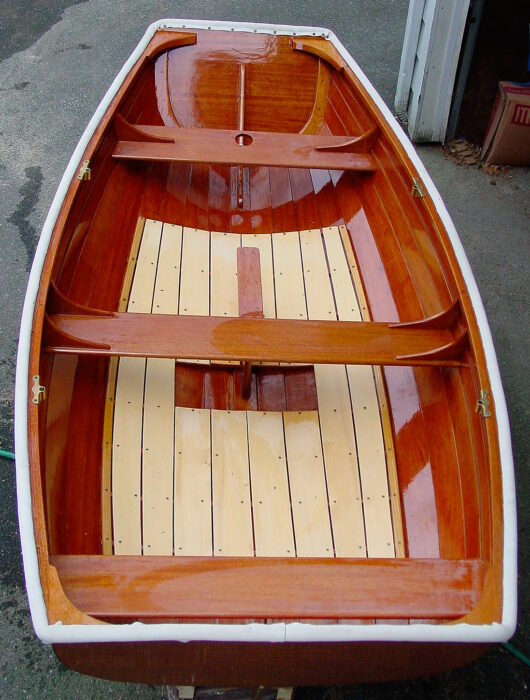 Jim Conlin
Jim ConlinFollowing the success of the Herreshoff pram, Jim was commissioned to build a modern-construction Concordia Baeteka pram. He was keen that the boat should be bright-finished and resemble the originals as closely as possible but was unable to find suitable plywood. Instead, he vacuum-bagged a Honduras-mahogany veneer to 1/8″ okoume plywood.
For the Dark Harbor couple, he built a cedar-strip version of the L. Francis Herreshoff pram described in John Gardner’s Building Classic Small Craft. Soon after delivering it, Jim received his second commission: building a replica of the Concordia Baeteka pram for LUNA, a 40′ Concordia yawl launched in 1962. Researching the Baeteka, which had been supplied with early Concordia yawls, took Jim across southern New England to look at plans and survey surviving originals. He decided to keep the look of the original lapstrake prams but to update the construction with glued-lapstrake ply. “I couldn’t find the right plywood,” he says, “So I vacuum-bagged Honduras mahogany veneer onto 1⁄8″ okoume plywood. It looked right and was good to work with.” The project took far too long to be financially viable but, Jim says, “It was a good boat and started a resurgence of interest in Baeteka prams among other Concordia-yawl owners.”
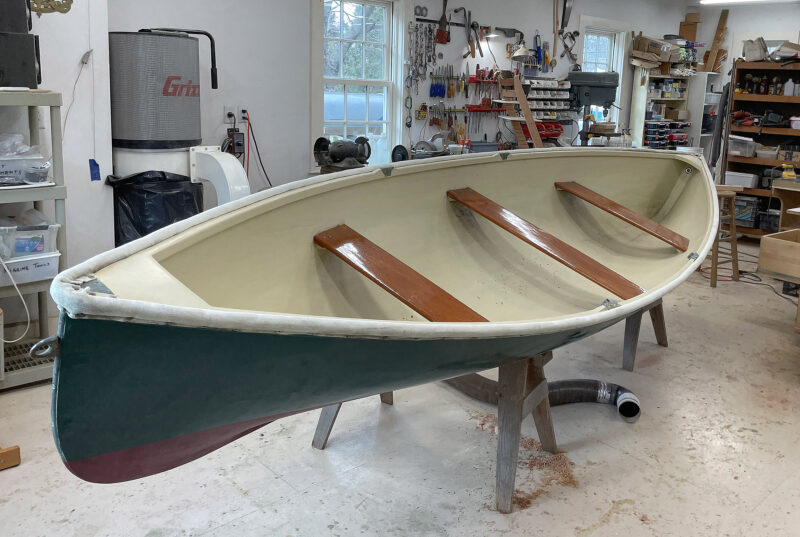 Jim Conlin
Jim ConlinThe 16’ Cape Split peapod was built in Jim’s new dream workshop—all light and space and easy access.
In 2015, Jim built a new house with the workshop he’d always wanted: “Big doors, easy entrance, good heat and light.” Over the years since, he’s built a number of small boats from a 16′ cedar-strip Cape Split peapod to a replica 17′, 1908 Palmer Fantail Launch, which he built with a friend who had a 1908 one-lung engine that needed an appropriate boat. And along the way he built a rowboat for his nephew’s six-year-old son. “It’s the simplest possible 7′ flat-bottomed skiff: plywood, ’glass tape, Styrofoam blocks for seats and flotation. But after I built the first one, I started getting requests for more. I’ve built seven of them.”
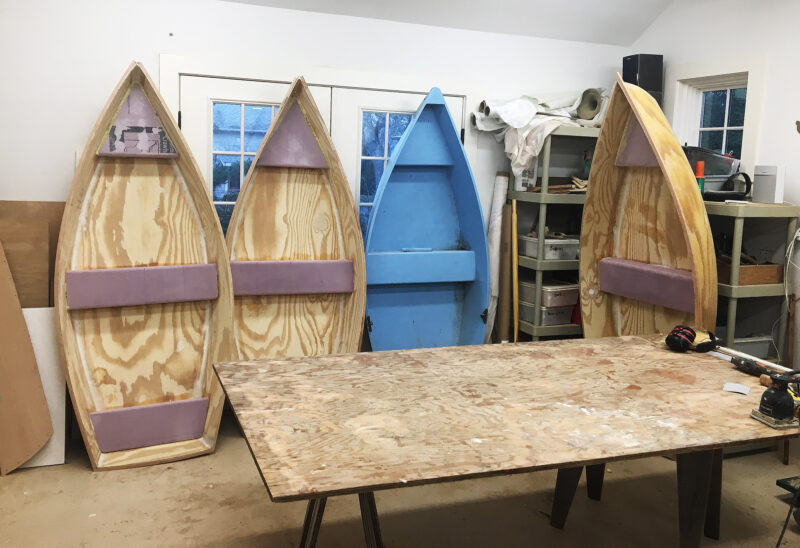 Jim Conlin
Jim ConlinThe simple, flat-bottomed plywood skiff designed by Jim for a young family member is comprised of 11 wooden parts—seven solid and four plywood—three Styrofoam blocks and some fiberglass and epoxy.
Jim’s most recent project is a 22′ double-ended sloop. Long an admirer of L.F. Herreshoff’s Rozinante, and Sydney Herreshoff’s Arion, he was on the hunt for a boat that combined the grace of those classic canoe-sterned designs with very light displacement, modern construction, and reasonable cost. He found Joel White’s Fox Island Class.
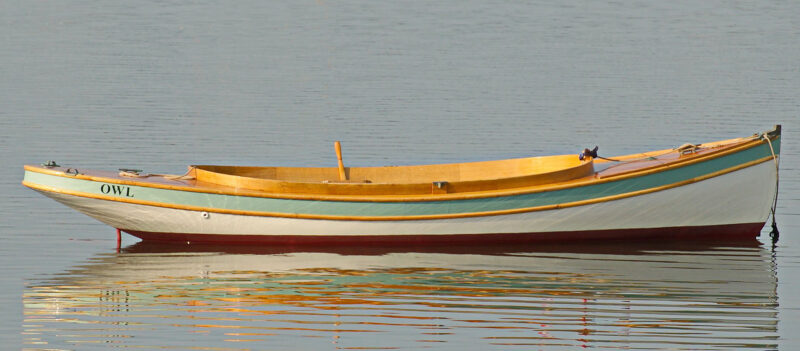 Jack Haley
Jack HaleyJim and his friend, Jon Armstrong, built OWL to accommodate Jon’s single-lung engine. A replica of a 1908 17′ Palmer launch, OWL included custom bronze fittings cast to patterns fabricated by Jim, and finishing details by Jon such as book-matched planking in the aft deck. Jon “is a very talented woodworker,” Jim says. “Anything in OWL that’s fancy, he did.”
The Fox Island is designed for glued-lapstrake plywood construction over laminated frames. Jim decided he would build his hull of ’glassed cedar-strip planking. He had completed two-thirds of a yacht design course and was happy to meet the challenge of the redesign. But he was “more daunted by the 955-lb lead fin keel. I didn’t want anything to do with molding it or paying to have one manufactured.” Fortunately, the Joel White–designed keel was a close match to the J24 keel and “at that time, early J24s with mushy balsa cores were being given away.” Jim found a suitable candidate at a boatyard in Westport Point, Massachusetts, parted with $100 to take ownership, and had the crew there separate the keel and spars from the rest of the boat. “I love the idea of recycling old boat parts into new boats,” he says. “It saves time and money and makes otherwise impossible boatbuilding projects financially viable.”
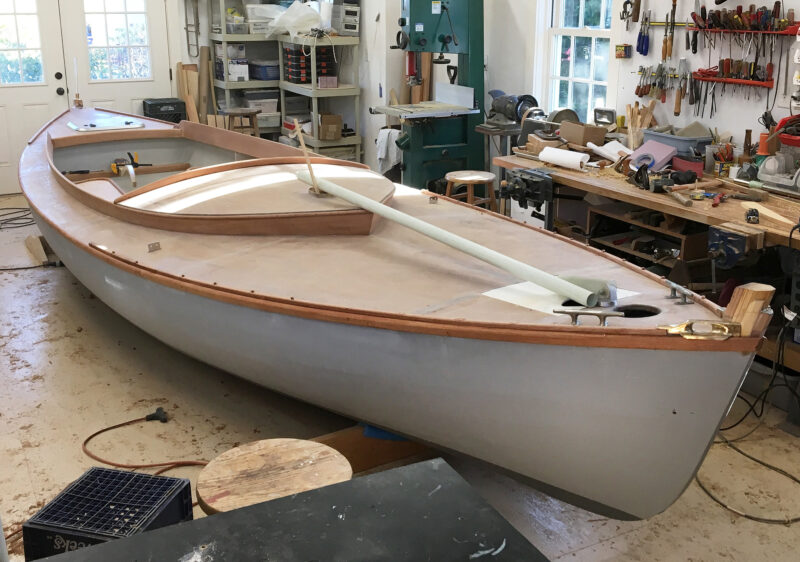 Jim Conlin
Jim ConlinSOME PIG under construction in January 2021. The panel in the foredeck gives access to a well that contains the furling mechanism. From there the furling lines and jibsheet are routed under the deck to the aft end of the cuddy where they are easily to hand for the helmsperson or crew.
Jim turned his attention to the hull design. With the help of a friend, he re-lofted the Fox Island lines with round sections and, assuming that a cedar-strip version would be lighter than the original lapstrake hull, brought the draft up about an inch. Other than that, Jim left the lines of the hull unchanged.
The sail plan was reworked from scratch to suit the J24 mast and boom and to incorporate a roller-furling self-tacking jib. Jim shortened the mast by about 2′ 6″ and raised the gooseneck about 8″. The mainsail, he says, is very like that of the J24 but nearly a foot shorter in the luff, while the jib is much shorter in the foot, has a jib boom (made from a piece of windsurfer mast), an on-deck traveler, and a furler tucked beneath the deck in a well. The jib’s furling line, outhaul, and double-ended sheet are also led under the foredeck. “Concealing the many jib control lines under the foredeck and inside the jib club took the most head-scratching,” Jim says, “but it came out tidy and works well.”
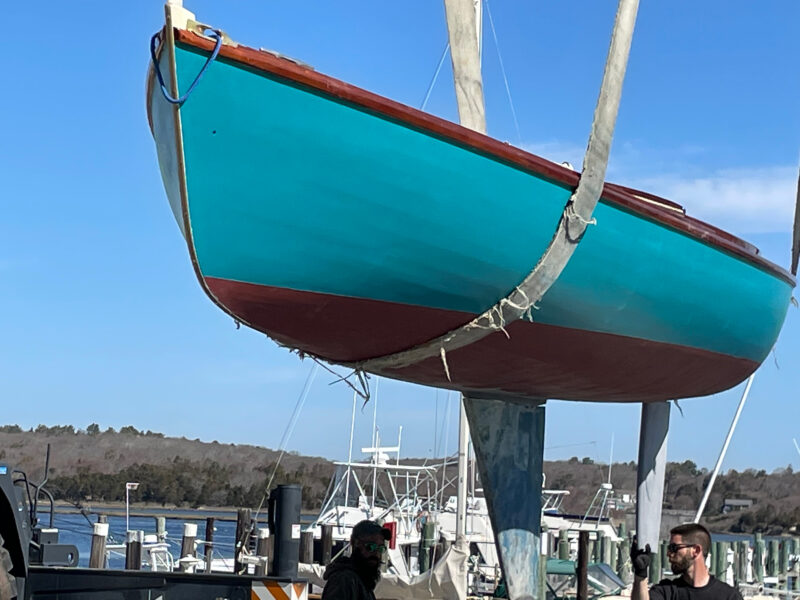 Jim Conlin
Jim ConlinThe day of SOME PIG’s launching in Westport, Massachusetts, was exciting, but less so than the day the yard crew lowered the hull onto the keel and the bolts lined up perfectly with the holes in the bottom of the boat.
As the days of COVID-19 took over through 2020 and into 2021, Jim worked alone on the build. When friends did come by to check on progress or offer advice, they came wearing masks and rarely more than one at a time. The project, says Jim, “kept me cheerful during those 15 months of isolation.”
The boat was to be named SOME PIG. “My wife and I were rereading E.B. White’s Charlotte’s Web in which the spider announces that the small farm pig, Wilbur, is not just any pig. It struck me that that was true of the new boat: it may look like a classic keelboat, but it’s light as can be with a decidedly modern underbody. Plus, E.B. White was Joel White’s father, so there was a sweet connection.”
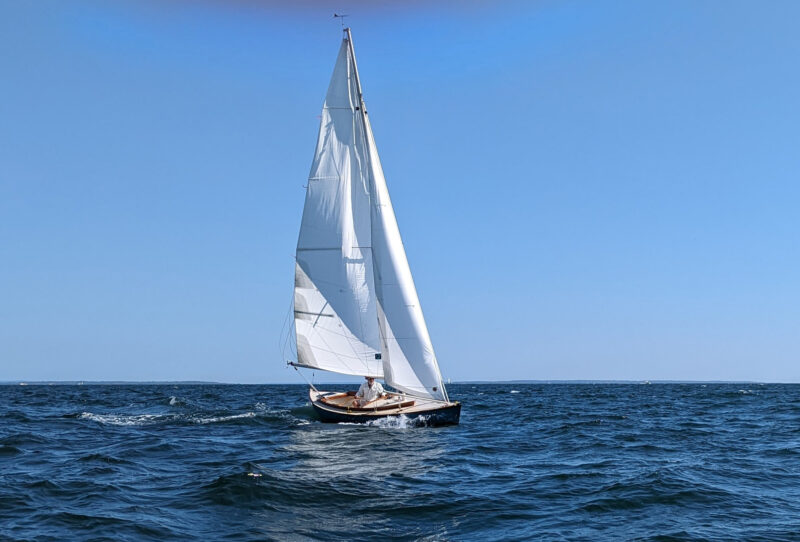 Walter Piescik
Walter PiescikJim typically sails SOME PIG singlehanded. Learning how to trim the sails to their optimum advantage occupied much of his time during his early outings. In particular, he says, the jib is a “fussy sail to trim.”
Jim built SOME PIG of 5⁄16″ x 1″ Alaska yellow-cedar strips. He describes the construction as “straightforward strip composite with beefy floor timbers to receive the five bolts that stuck out of the keel.” Knowing that he would be sailing on Buzzards Bay, where winds can build quickly, and that the boat’s sail plan would be generous, Jim built in bulkheads forward and aft of the cockpit, creating large buoyancy tanks in the boat’s ends. “I built them because I felt that getting knocked down and swamped was a real possibility,” he says. “But after three seasons of sailing, I’ve had no such excitement.”
He kept the trim simple and classic: the rails, toerails, and coamings are varnished African mahogany, the floorboards unfinished white cedar, and everything else is painted. But when it came time to install the hardware, Jim felt that “the boat deserved proper fittings and found some on eBay and at consignment shops.” When he couldn’t find any suitable off-the-shelf bow chocks, he made patterns for Herreshoff-style chocks, had them cast, and finished them himself.
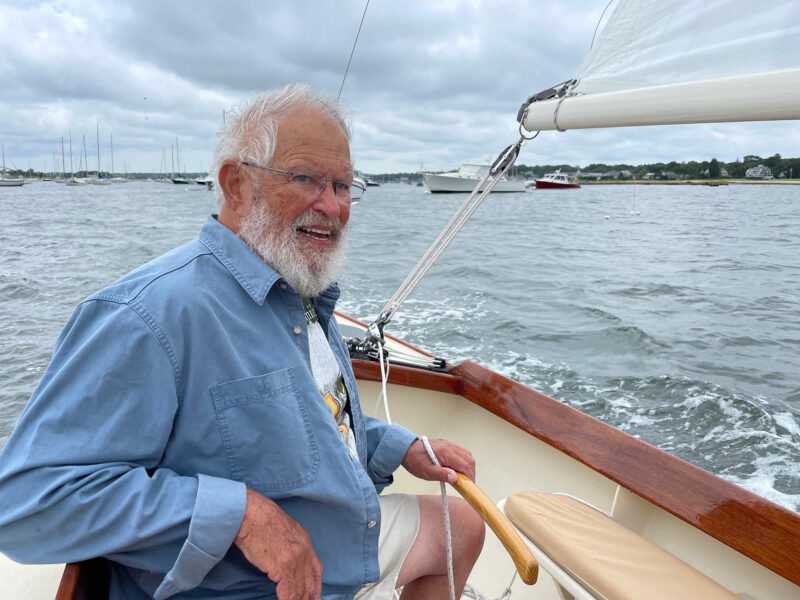 Anne Conlin Koffel
Anne Conlin KoffelJim Conlin at the helm of SOME PIG. The boat is lively, and Jim keeps the mainsheet handy most of the time. Since this shot was taken in August 2021, Jim has added hooks on the tiller where he can temporarily hold both the mainsheet and the traveler.
In May 2021 SOME PIG left the workshop for the Westport Point boatyard where the hull was lifted onto the keel. It was a memorable occasion. “To my moderate astonishment,” Jim says, “it fit! The five bolts went into the five holes. It was quite the moment!” A few days later SOME PIG was quietly launched and rigged. Jim was joined by some “adventurous friends who came on test flights. The first dozen outings were adventures, and we had surprises but no breakages or other mishaps.”
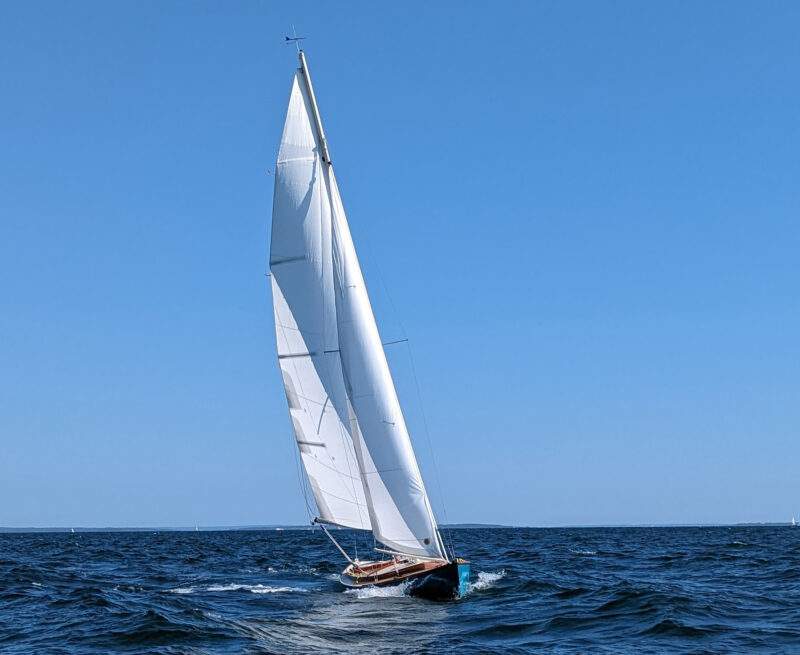 Walter Piescik
Walter PiescikWith the jib furler housed in a well below the deck, SOME PIG’s stem and foredeck are uncluttered and apparently free of modern, mechanical conveniences.
Since those early days of testing and tweaking, Jim has gradually become comfortable with the boat. His dream of having a classic double-ender that performs like a modern-day racer has been fulfilled: “She’s the liveliest, most enjoyable daysailer I’ve sailed in my 80 years; she goes like mad in lighter airs, and “she balances very nicely. I guess that’s beginner’s luck!”![]()
Jenny Bennett is managing editor of Small Boats.
Do you have a boat with an interesting story? Please email us. We’d like to hear about it and share it with other Small Boats readers.
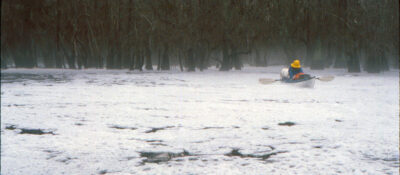
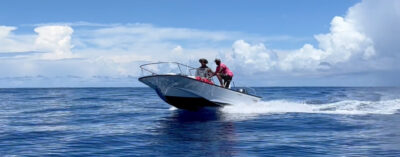
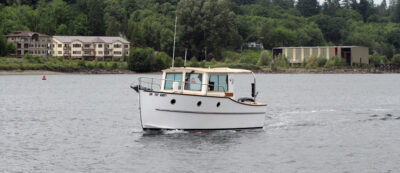
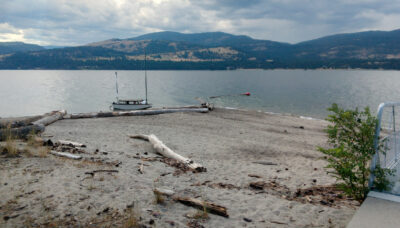
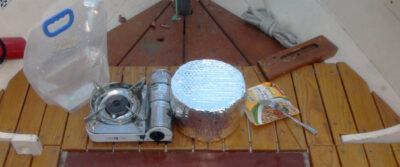
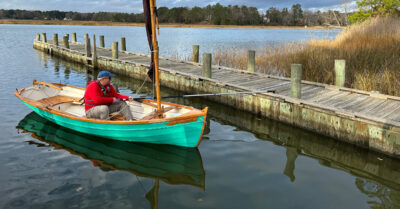
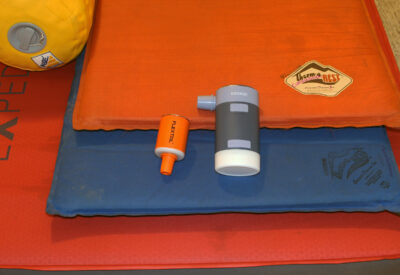


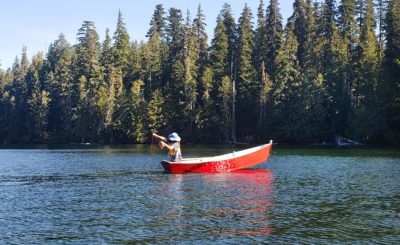
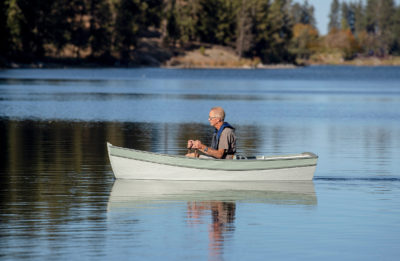
Gorgeous boat! Nice 🙂
I built two small boats in 1969, one a canoe/kayak with a fore and aft decks, large enough for two teenagers to paddle across a fairly large lake in Texas. The other was a small sloop.
Your vessels are clearly quite clean and beautiful.
Thank you for sharing.
I’ve had multiple opportunities to sail this boat with Jim. It really is “Some Perfect” boat for a nice day on Buzzard’s bay! Great short story about Jim, as well. Thanks Jenny!
Model Airplanes too. Sounds very similar to my growing up in Old England.
A few years ago I sold my beloved IF boat and felt like I should by now be thinking of a motorboat I headed in that direction. However I myself have always admired the White double enters and wish I had the time and skills to build one. Locally, a friend has the other White ( L.F. Herreshoff style) double ender but with a transom! I admire her immensely.
I have put much energy and time into my motorboat project. It has been very frustrating to say the least. After it nearly sank in 2021 due to Covid restrictions, dried out lands, and a failed battery I got it going wonderfully well in 2021 up to hull speed. Such are old clinker wooden boats I guess. Thanks for sharing your boat building adventures.
Where oh where is that Cape Split Peapod today?
It’s here in S. Dartmouth, MA. Needs a new home.